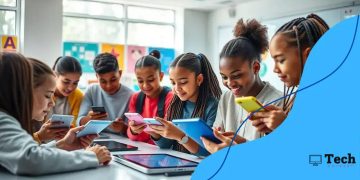The future of online learning platforms: what to expect

The future of online learning platforms will be defined by personalized learning paths, innovative technologies like AI and VR, and strong community engagement to enhance the educational experience.
The future of online learning platforms is an exciting terrain that invites curiosity. Have you ever wondered how your education might evolve with these new tools? Let’s explore this journey together.
Emerging technologies in online learning
With rapid advancements in technology, emerging technologies in online learning are transforming how we acquire knowledge. It’s fascinating how tools and innovations reshape our educational experiences.
Artificial Intelligence in Education
One significant trend is the rise of artificial intelligence (AI) in educational platforms. AI enables personalized learning experiences by adapting to each student’s needs. This technology analyzes performance and provides tailored resources, making learning more effective.
Virtual and Augmented Reality
Virtual reality (VR) and augmented reality (AR) are also breaking new ground. These immersive technologies create engaging learning environments. For example, students can explore historical sites or conduct virtual science experiments, enhancing understanding through interactive experiences.
- AI-driven personalized learning.
- Immersive VR educational experiences.
- AR tools that enhance real-world learning.
Moreover, platforms that incorporate gamification make learning fun and engaging. By adding game-like elements, students remain motivated and focused on their learning goals. This approach can significantly improve retention rates.
Another technology making waves is mobile learning. With smartphones and tablets, education is no longer confined to classrooms. Students can learn anytime, anywhere, allowing flexibility that suits their lifestyles.
Cloud Computing and Collaboration Tools
Cloud computing has revolutionized online learning by enabling easy access to resources and collaborative tools. Students can work together on projects and share ideas seamlessly, regardless of location. This enhances teamwork skills and fosters a sense of community.
Lastly, data analytics plays a critical role in understanding student behavior. By analyzing learning patterns, educators can refine their methods, ensuring that they can support students effectively. This data-driven approach helps to identify areas for improvement, ultimately leading to better learning outcomes.
Benefits of personalized learning paths
Personalized learning paths offer significant advantages to students in the online learning environment. By tailoring educational experiences to individual needs, schools can enhance student engagement and success.
Increased Engagement
One of the primary benefits of personalized learning paths is increased engagement. When students feel that their learning is relevant to their interests and abilities, they are more likely to participate actively. This can lead to a deeper understanding of the material.
Customized Learning Experience
Another advantage is the ability to create a customized learning experience. Students can progress at their own pace, spending more time on challenging topics while moving quickly through areas where they excel. This flexibility accommodates different learning styles and speeds.
- Adapts to individual strengths and weaknesses.
- Supports varied learning preferences.
- Promotes self-directed learning.
Moreover, personalized learning paths can help identify gaps in knowledge. By monitoring progress, educators can pinpoint areas needing improvement. This allows for timely interventions, helping students stay on track.
Also, these tailored paths encourage the development of critical thinking and problem-solving skills. Students are given opportunities to engage in real-world scenarios, which helps them apply what they learn in relevant contexts.
Building Confidence
Furthermore, personalized learning helps build confidence. When students achieve their goals, they feel a sense of accomplishment. This boosts their self-esteem and motivates them to take on new challenges. As they see their progress, they become more invested in their education.
Finally, teaching strategies employed in personalized learning can foster better teacher-student relationships. Educators can focus on individual student needs, enhancing support and communication. This cultivates a more positive learning environment where students feel valued.
Challenges faced by online platforms

Online platforms face several challenges that can affect the quality of education they provide. Understanding these obstacles is crucial for educators and students alike.
Technical Issues
One major challenge is technical issues. Students may encounter problems such as slow internet connections or software malfunctions. These issues can interrupt learning and lead to frustration. Furthermore, not all students have access to reliable technology, which can create disparities in the learning experience.
User Engagement
Another challenge is maintaining user engagement. In a virtual environment, it can be difficult for students to stay motivated. Without face-to-face interaction, some learners might feel isolated and less inclined to participate. This lack of engagement can lead to poor academic performance.
- Students may struggle with time management.
- Distractions at home can hinder focus.
- Online classes require self-discipline.
Moreover, instructors often need training to effectively use online teaching tools. Not all educators are comfortable with technology, which can lead to ineffective teaching practices. Providing adequate professional development is essential for overcoming this hurdle.
Additionally, creating a supportive online community can be challenging. Building relationships between students and teachers needs intentional efforts in a digital setting. Without a sense of community, students may feel disconnected, which can hinder their learning experience.
Assessment and Feedback
Assessment can also pose a challenge for online platforms. Traditional testing methods may not translate well to a virtual environment. Educators must find new ways to evaluate student understanding accurately. Feedback can become less immediate and meaningful in an online context.
Lastly, keeping up with rapid technological advancements is crucial. Online platforms must continually adapt to new tools, trends, and educational practices to remain effective. This constant need for adaptation can strain resources and require additional training for staff.
The role of community in learning
The role of community in learning cannot be overstated. A sense of belonging can significantly enhance the educational experience for students. When learners feel supported by their peers and teachers, they are more likely to thrive.
Peer Support
One of the main benefits of a strong community is the availability of peer support. Students can share ideas and collaborate on projects, which strengthens their understanding of the material. Working together encourages a sense of camaraderie, making learning more enjoyable.
Encouragement and Motivation
Community involvement also fosters encouragement and motivation. When students see their peers succeed, it inspires them to strive for excellence as well. This positive environment pushes learners to achieve their goals, enhancing overall academic performance.
- Access to diverse perspectives and experiences.
- Opportunities for teamwork and collaboration.
- Sharing of resources and study materials.
Moreover, a strong community contributes to the development of social skills. Communication and teamwork are vital for success in both academic and real-world settings. Students learn to express their ideas clearly and work harmoniously with others, which are crucial skills for their futures.
Online learning platforms can facilitate community building through discussion forums, group projects, and virtual study sessions. These tools help bridge the gap that physical distance can create. Students can interact, ask questions, and support each other despite being remote, ensuring that they never feel isolated.
Teacher Interaction
The role of teachers in fostering community is equally important. Educators should create an inclusive atmosphere where every student feels valued. By being approachable and responsive, teachers can build trust, encouraging students to participate actively in discussions.
A community of learners empowers students to take ownership of their education. In an engaged community, learners feel responsible for one another’s success. This shared responsibility cultivates a culture of learning where every student contributes positively to the group.
Future trends in digital education
Future trends in digital education are already shaping how students learn and interact with content. As technology continues to evolve, educators and students must adapt to these changes.
Artificial Intelligence and Learning Analytics
One major trend is the incorporation of artificial intelligence (AI) and learning analytics. AI can analyze student data to identify strengths and weaknesses, enabling personalized recommendations. This tailored approach helps students engage with the content, improving their learning outcomes.
Gamification in Education
Additionally, gamification is on the rise. By integrating game-like elements into lessons, educators can make learning more enjoyable. This strategy encourages participation and can significantly boost motivation.
- Points, badges, and leaderboards create a competitive environment.
- Challenges and rewards make learning interactive.
- Students develop problem-solving skills through engaging activities.
Moreover, the use of virtual reality (VR) and augmented reality (AR) is set to increase. These tools can transport students to different places and experiences, enriching their understanding of complex subjects. For instance, a history lesson could involve a virtual tour of ancient civilizations.
Alongside these technologies, collaborative tools are becoming essential. Platforms that facilitate group work and discussions help build a sense of community, even in online settings. Students can communicate and share ideas, enhancing their teamwork skills.
Focus on Social-Emotional Learning
There will also be a growing emphasis on social-emotional learning (SEL). As education becomes more integrated with digital tools, addressing students’ emotional and social development is crucial. Schools will prioritize creating supportive environments where students feel safe expressing themselves.
Furthermore, educational institutions are likely to embrace flexible learning models. Blended learning, which combines online and in-person classes, allows students to choose how they learn best. This flexibility caters to diverse learning styles and needs.
In summary, the future of online learning platforms is full of promise. As technology continues to advance, we can expect to see significant changes in how we learn and teach. The integration of personalized learning paths, community engagement, and innovative technologies like AI and VR will enhance the educational experience for everyone involved. By embracing these changes, we can create a more inclusive, engaging, and effective learning environment that meets the needs of all students. The journey in digital education is just beginning, and it will only get better.
FAQ – Frequently Asked Questions about Online Learning Platforms
What are personalized learning paths?
Personalized learning paths are tailored educational experiences that adapt to a student’s individual needs, strengths, and interests.
How does community play a role in online learning?
Community involvement fosters support and motivation among students, enhancing engagement and collaboration in the learning process.
What innovative technologies are being used in online education?
Technologies like artificial intelligence, virtual reality, and gamification are increasingly integrated into online learning to enhance interactivity and engagement.
What is the future potential of digital education?
The future of digital education aims to create a more inclusive, flexible, and effective learning environment that meets the diverse needs of all students.






